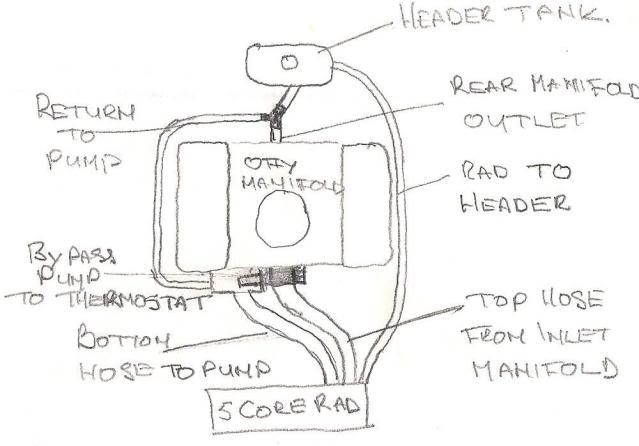Hello Westy, I dont think your answer lies in changing any of the plumbing although, it does seem that the cooling function is slightly too weak, as witnessed by the effect of adding the second radiator.
You have not mentioned whether the main radiator fan is trying to push air through the fins or drag it through.
Pushing air through, results in a lot of deflection and unproductive turbulance.
Dragging it through mean the airflow is much smoother with no deflected or wasted fan effort.
You also mention a 5 core radiator. Thats a lot of cores for the air to pass through, and they all have to be effectively capable of transferring their heat to the passing air.
Just possibly, the heat transfer of the last 1 or 2 cores is limited by the amount of heat already absorbed by the moving air, so the cooling process efficiency is impaired. So, more air flow may be called for - see later.
Your system design appears to be capable of maintaining a reasonably stable temperature when running at or around the 100 deg C mark and because you are simply running too hot as opposed to suffering surges of overheating then I suggest two discrete actions, designed to improve the extraction of heat from the radiator fins and/or to do it sooner.
1 Change the main fan/radiator thermostat switch to a lower temperature unit.
AND
2 Increase the air flow over the radiator fins by one of the following methods
. a) increase fan diameter
. b) increase the number of fan blades
. c) increase the pitch of the fan blades
. d) increase the fan speed
That way the "fan cooling" part of the heat transfer process - as opposed to the "ram air" part - starts a little earlier in the temperature rise cycle and with the fan running sooner your temperature may not be going to get so high.
And of course, the increased air flow speaks for itself.
It's debateable, but you might also get some mileage out of fitting a lower temperature thermostat.
Essentially the thermostat primarily determines the point at which the cooling process actually commences, but because it starts a little sooner, it may also have the effect of limiting the maximum temperature achieved. But like I said, its debateable.
There is also another another factor to consider. The type of fan control being employed. Think about it this way?
On the original Rover V8 system the main cooling fan was a viscous unit with its temperature sensing element immediately behind the centre of the radiator, so as to minimise the delay between the sensing of the critical temperature to engage the fan and the virtually instant cooling effect of the engaged viscous.
It was also a very subtle system that had a variable effect on the viscous fan speed. A true negative feedback system with little or no thermal delay between the radiator and the sensing element of the viscous unit.
Depending upon the location of your electric fans thermostat switch, I suspect that it is simply an on/off switch with no subtle temperature control and is at the mercy of the hysteresis loop involved.
Thus the position of your fan thermostat switch may need to be optimised or experimented with, to ensure there is the minimum of thermal delay between the heating effect and the urgent need of cooling.
You may be interested to read some stuff about the original RV8 cooling system as it applies to the SD1 Efi system,not necessarily a solution to your problem but never-the-less will add food for further thought.
http://www.vintagemodelairplane.com/pag ... ing01.html
Whichever god you pray to, good luck!









